

Volume Two December 2022
Online Magazine From Village Earth
2010 - 2022
Free
Dr Margi Prideaux Surviving Climate Change, Now

©liveencounters.net volume two december 2022 Celebrating 13th Anniversary L I V E E N C O U N T E R S M A G A Z I N E
Village boy, Nam (river) Ou, Muang Ngoy, Laos. Photograph by Mark Ulyseas.
©Mark Ulyseas
Support Live Encounters. Donate Now and Keep the Magazine Live in 2023
Live Encounters is a not-for-profit free online magazine that was founded in 2009 in Bali, Indonesia. It showcases some of the best writing from around the world. Poets, writers, academics, civil & human/animal rights activists, academics, environmentalists, social workers, photographers and more have contributed their time and knowledge for the benefit of the readers of:


Live Encounters Magazine (2010), Live Encounters Poetry & Writing (2016), Live Encounters Young Poets & Writers (2019) and now, Live Encounters Books (August 2020).
We are appealing for donations to pay for the administrative and technical aspects of the publication. Please help by donating any amount for this just cause as events are threatening the very future of Live Encounters.
Mark Ulyseas Publisher/Editor

markulyseas@liveencounters.net
All articles and photographs are the copyright of www.liveencounters.net and its contributors. No part of this publication may be reproduced without the explicit written permission of www. liveencounters.net. Offenders will be criminally prosecuted to the full extent of the law prevailing in their home country and/or elsewhere.
December
2022 december volume two © liveencounters.net Volume Two
2022
Om Shanti Shanti Shanti Om

©liveencounters.net volume two december 2022 Celebrating 13th Anniversary
Contributors
Dr Margi Prideaux – Guest editorial Stephen Harrod Buhner José Truda Palazzo, Jr. Katie Costello Tina Claffey Wolfgang Widmoser Tim Tomlinson Carl Scharwath Afaf Elbousty Anni Wilton-Jones

2022 december volume two © liveencounters.net
Volume Two December
2022

©liveencounters.net volume two december
G U E S T E D I T O R I A L
2022 Celebrating 13th Anniversary
Dr Margi Prideaux. Photograph by Geoff Prideaux.
Margi Prideaux has lived and breathed wildlife and international politics and law almost every day for the past 33 years. As an international negotiator and independent academic with a PhD in wildlife policy and law, she has tuned her words to inform policy audiences in over 20 different international conservation processes. After losing her home, farm, and wildlife sanctuary to the unprecedented and climate-driven Australian Black Summer wildfires, she is spending the next decade as advocate for communities (human and non-human) impacted by unfolding climate chaos, reflecting a radically new direction for her writing in the period to come. Her latest book is FIRE: A Message from the Edge of Climate Catastrophe. linktr.ee/margiprideaux
Dr Margi Prideaux Surviving Climate Change, Now Towards Relational Thinking
News from the United Nations about the shortfall in national emission pledges is echoing across the world. To my diplomatically tuned ear, the United Nations’ latest message vibrates with genuine fear. I’ve spent my career inside the international negotiation space and when a United Nations agency says there is ‘no credible pathway to 1.5°C in place’, this diplomatic speech really means achieving that goal is now impossible. This desperate position is now clear, despite legally binding promises made by the world’s governments in 2015 to prevent temperatures rising by over 1.5°C above pre-industrial levels.
The chair of the next climate meeting (COP27), Sameh Shoukry, has warned the geo-political climate may cause even further slippage. ‘If countries are to backtrack or deviate from their commitment, and their efforts to maintain these agreements and understanding made in Paris and Glasgow, we will be on track to have over 2°C and maybe up to 3.6°C, according to the science available,’ he said in an interview ahead of the meeting.
The situation could not be more grave. A year ago the preeminent scientific body, established by governments to advise on the impacts of climate change—Inter governmental Panel on Climate Change (IPCC)—warned that climate change was already affecting every region on Earth, in multiple ways, and that the scale of change was escalating—increasing heat waves, longer warm seasons and shorter cold seasons, more apocalyptic wildfires, killer heat domes, catastrophic rain bombs, lethal floods and mudslides, deadly droughts, and violent sandstorms. Chillingly, they warned, the critical tolerance thresholds for agriculture and human health will soon be crossed.
2022 december volume two © liveencounters.net
M A R G I P R I D E A U X
© Margi Prideaux
That we find ourselves at COP27 with an impossible task is not a failure of science, or of the United Nations as the radical right would have you believe. Nor it is a failure of each one of us, although if we live in the wealthy west we shoulder responsibility for our rapacious consumption. The failure rests at the feet of governments across the world who sustain their power through a deal with the devil—the fossil fuel industry—and the promotion of the neoliberal myth that the market will fix everything.
Fearful of stating the brutal truth in case it upsets people not yet engaged with the climate chaos reality, progressive media is still scrambling for a hopeful solution—a hidden fix that can put us magically on track. Many commentators promote ‘hopium’, and an exclusive focus on reducing emissions, while failing to notice the disaster and disintegration around them caused by govern mental denial two decades ago. Caught in a mental warp that climate change is a problem for the future, their hopeful messaging only delays the inevitable reckoning.
Ahead of the commentators, people living through floods and fires and storms in many regions of the world have already woken from the dream, and are fearful of the escalation of climate changedriven disasters on their doorsteps. Their concern is immediate and real, but they lack climate chaos vocabulary and platforms, so no-one hears them. Yes, people want NetZero by 2050, but they also want to survive right now.
The United Nations Environment Programme (UNEP) is giving voice to this fear. Inger Andersen, UNEP’s Executive Director said at the release of their latest Emissions Gap Report, “We had our chance to make incremental changes, but that time is over. Only a root-and-branch transformation of our economies and societies can save us from accelerating climate disaster.”
Current climate pledges leave the world on track for a temperature rise of 2.4-2.6°C by the end of this century; levels that will cause a catastrophic breakdown of everything. The updated pledges since COP26 in Glasgow take less than one percent off projected 2030 greenhouse gas emissions when 45 percent is needed to limit warming to 1.5°C.
Meanwhile, climate-driven disasters are already eroding the fabric of society, now. The media’s citydriven attention has failed to notice that once a wildfire, or flood, or mudslide, or storm has landed,
©liveencounters.net volume two december 2022 Celebrating 13th Anniversary
G U E S T E D I T O R I A L
Time is up. The COP27 will fail and excuse the neglect away, because governments don’t serve the governed or Earth’s biodiversity. They serve the market, and the market is cutting us all loose.
and the immediate rescue has been done, the pain-filled ‘road to recovery’ is already chipping away at society’s resilience. Farmers, unable to pick up and rebuild again, are walking off the land. Rural towns, without infrastructure, are emptying. Business, without stock and customers, are shuting their doors. Entire communities are vanishing, lost to the ghettos of the city because insurance payouts were too small or denied, government decisions are too slow, and the reality that nothing is being done to adapt for future protection makes the risk of staying too high. People’s health is failing from wildfire smoke inhalation, toxic sewage-laden mud, or the debilitating trauma of PTSD. These are the long, hard, and often invisible stories of the fabric of people’s lives ripped and torn; of those lives being patched and rewoven through the fog of depression and fear that they have insufficient internal strength to get the job done. Nature—the forests, and rivers, and wetlands, and wild landscapes—has no-one left to defend it from the next cataclysmic climate-driven weather event. This is the story of the broken contract between governments and the governed in the face of climate chaos.
Absolutely, government should transform their economies and societies to achieve NetZero, but there is an immediate need that also requires radical attention. An urgent and facilitated discussion must start about how we survive the next colossal disaster that destroys our forests and our crops, crushes our homes, closes our transport, and stops our income. We need to look carefully at the biodiversity estate and commit localised action to protect what we can before it is lost forever, remembering fences around parks don’t protect these wild places. People do. But, right now and pretty much everywhere in the developed world, the collapse is unnoticed. Rural communities are waking to the reality that we are service providers to big cities with little internal resilience. We are dependent, and when disaster hits, we are broken.
Time is up. The COP27 will fail and excuse the neglect away, because governments don’t serve the governed or Earth’s biodiversity. They serve the market, and the market is cutting us all loose.
Realising this is to experience a twin existential crisis—that the world as we know it is collapsing and the world we newly face is life-threatening.
2022 december volume two © liveencounters.net
© Margi Prideaux M A R G I P R I D E A U X
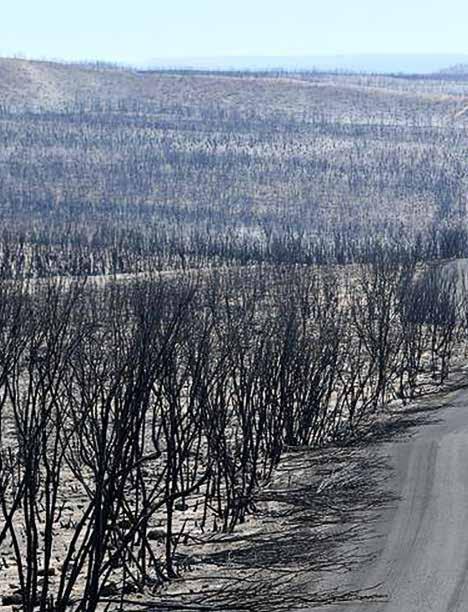
©liveencounters.net volume two
december
2022 Celebrating 13th Anniversary
G U E S T E D I T O R I A L
Kangaroo Island, post fire. Photograph by Margi Prideaux.
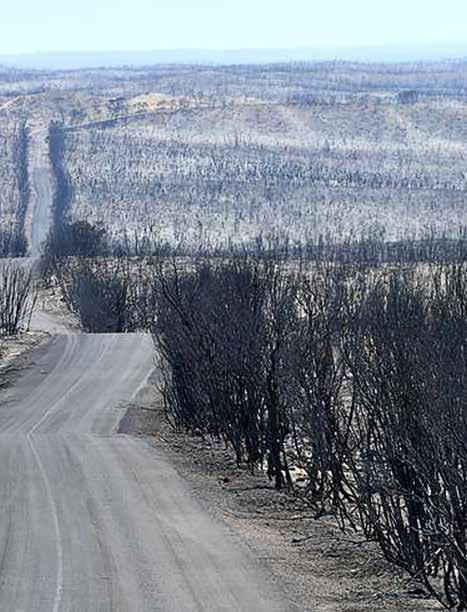
2022 december volume two © liveencounters.net © Margi Prideaux M A R G I P R I D E A U X
Ten years ago, writer Paul Chefurka penned an important essay, Climbing the Ladder of Awareness, about how each of us understands the unfolding global crisis. His essay proposes most of us fit somewhere along a continuum of awareness that can be roughly divided into five stages.
The first stage is dead asleep, where the individual believes there are no fundamental problems, just some shortcomings that can be fixed with the proper attention to rule-making. People at this stage live their lives happily, with occasional outbursts of annoyance around election times or the quarterly corporate earnings seasons.
The second stage is an awareness of one fundamental problem. Here the individual becomes engaged in one issue (climate change, overpopulation, peak oil, chemical pollution, overfishing, socio-political injustice) and becomes an ardent, vocal activist for their chosen cause, while being blind to any others.
At the third stage, people develop an awareness of many problems. They gather information from different places and their understanding of complexity grows. They worry about the prioritisation of problems in terms of their immediacy and impact, and can be reluctant to acknowledge fresh problems because their problem space is already complex enough.
By the fourth stage, their awareness of interconnection deepens; of the connections between many problems and the grave risk that solutions in one domain may worsen problems in another. They move to large-scale system-level thinking. It is at this stage the possibility that there may not be a solution creeps into their consciousness. Individuals in this space often withdraw into tight circles of like-minded individuals.
The fifth stage delivers the awakening that the existential crisis encompasses all aspects of life; where the knowledge that everything we do, how we do it, our relationships with each other, as well as our treatment of the rest of the biosphere and Earth is the core problem. At this stage, the floodgates open and despair and depression can take root.
©liveencounters.net volume two december 2022 Celebrating 13th Anniversary
G U E S T E D I T O R I A L
My community has a fleeting opportunity. We are armed with knowledge like never before in human history. Our elders live longer and their words are captured and shared. Science can speak to us with real-time revelation and advice. We are connected and literate, and we have all experienced or witnessed profound trauma. We have a rare, brief, precious moment to develop a shared communityowned plan about how to face the future, and start building our resilience around that goal.
Chefurka suggests that people in stage five have two choices. After pondering this ladder of aware ness for most of the past year, I agree with him. There is an inner and an outer path. The inner path involves re-framing how you see and function in the world in terms of your consciousness and self-awareness. Those who have arrived at this point have no interest in hiding from or easing the painful truth, rather, they wish to create a coherent personal context for it. Personal spirituality is a path often followed. The fifth level’s outer path is one of adaptation, community-building, and local resilience, while never denying the grave consequences for all that will be lost.
Says Chefurka, ‘From my observations, each successive stage contains roughly a tenth of the number of people as the one before it. So, while perhaps 90 percent of humanity is in stage one, less than one person in ten thousand will be at stage five (and none of them are likely to be politicians). The number of those who have chosen the inner path in stage five also seems to be an order of magnitude smaller than the number who are on the outer path.’
After the experience of a lifetime—a catastrophic climate-change driven firestorm that erased my world—and the focus that becomes seared in a painful moment, I have reached a point where I am done with my life before. I am standing with my feet firmly in the fifth stage, and I have witnessed many in my community leaping with deep discomfort to this same place.
As I’ve travelled through my pain, I have learned from my community, listening to what they have said, but also to the wisdom held between the words; to the meaning deep within people’s eyes or in the catch of their voice as they hold something back and glance away. My community has experienced the beginning of the climate change curve. We know we cannot hand this hell to tomorrow.
My community has a fleeting opportunity. We are armed with knowledge like never before in human history. Our elders live longer and their words are captured and shared. Science can speak to us with real-time revelation and advice. We are connected and literate, and we have all experienced or witnessed profound trauma. We have a rare, brief, precious moment to develop a shared communityowned plan about how to face the future, and start building our resilience around that goal.
2022 december volume two © liveencounters.net
M A R G I P R I D E A U X
© Margi Prideaux
By necessity, my community needs to plan for extreme wildfires. That is our grave climate chaos threat. Other communities will face floods, or droughts, or heat, or sand, or inundation from the sea. Extreme weather, which the World Meteorological Organisation now calls the ‘day-to-day face of the climate emergency’, that is already exacting a heavy toll on human lives and on nature.
The United Nations warns us that even previously unaffected countries are likely to see uncontrollable wildfire blazes and other catastrophes within the next 20 years. They make the sobering point that governments can minimise the risk of extreme events by being better prepared and building back better once a climate-driven storm rages through, yet there is little evidence of government aware ness on this level. In Australia the failure of the past three years is heartbreaking. Despite multiple floods and fires, the political focus remains on the bright and shiny future of targets and emissions, and future technologies, wilfully overlooking the terrible human and biodiversity cost being paid right now.
Communities everywhere need to recognise their government won’t save them. The contract is broken. We all need to take community-level control and consciously adapt to living in a world with more apocalyptic wildfires, killer heat domes, catastrophic rain bombs, lethal floods and mudslides, deadly droughts, and violent sandstorms.
The time for pretty words and hollow targets is over. We must adapt to survive and save what we can before it is too late.
©liveencounters.net volume two december 2022 Celebrating 13th Anniversary
G U E S T E D I T O R I A L

2022 december volume two © liveencounters.net
M A R G I P R I D E A U X
© Margi Prideaux
Kangaroo Island, fireground, photograph by Anne McClean.

©liveencounters.net volume two december 2022 Celebrating 13th Anniversary B O O K R E V I E W
Book available at: https://linktr.ee/margiprideaux
Author, interdisciplinary and independent scholar, polymath, autodidact, Fellow of Schumacher College UK and head researcher for the Foundation for Gaian Studies for the past thirty years. stephenharrodbuhner.com

Stephen Harrod Buhner
Review of Dr Margi Prideaux’s
Fire, October 2022
FIRE: A Message from the Edge of Climate Catastrophe should be on the bookshelf of every person who is concerned about climate change or who has felt ecological grief. Most especially it needs to be on the desk of everyone who is studying and writing about what we are facing. (Bill McKibben and Kim Stanley Robinson, pay attention.) It is an egregious failure on their part if it is not.
FIRE explores the real impacts of climate change on individual human beings and their community. In Prideaux’s stories and words you can both hear and feel the deep mourning and terrible grief that accompanies the reality of what we are facing. It comes like a hurricane, a tsunami, an avalanche – but one made of fire. And nothing, nothing at all can stand in the way of fire unchained; there is no technocratic fix for the great powers of Earth when they are freed to do as they wish. Unchained Air, Earth, Fire, and Water is what we are facing now. Their power, as media reports tell us every day, dwarf our own.
Make no mistake, Prideaux’s story is our story; it is a single instance of what the entire human species is facing. And it has at its core an emotional dimension that is nearly unbearable in its impact. It forces those of us who are caught on the front lines into an existential re-examination of our selves and our relation to a natural world teetering on the edge of complete collapse.
2022 december volume two © liveencounters.net
S T E P H E N H A R R O D B U H N E R
© Stephen Harrod Buhner
Unlike most articles and books on climate change Prideaux does not offer simplistic or techno-utopian solutions. Differently than so many she has turned her face to the truth, that climate change is already here, that tipping points have been passed, that there is nothing that can be done to stop what it happening. And from that she arrives at the core truth of what this means: we must adapt and we will have to do that on our own. She is clear that this does not mean adaptation in the old sense of using the rational mind to exert control over nature but rather coming once again to accept that there are forces here far greater than ourselves, that it is the 4.5 billion year old life form we call Earth who makes the rules here, that we are ecological beings on an ecological planet, and from that, there is no escape. Our own climate of mind must change; that is the only way as a species that we can adapt and survive. In Prideaux’s story you will see what true adaptation involves.
I do not say these things lightly, I mean every word. Fire is brilliant and powerful and deeply, deeply moving. It is not a book I will easily forget. And I suspect that as the years of climate collapse roll on, I will think of and turn to it many times.
©liveencounters.net volume two december 2022 Celebrating 13th Anniversary B O O K R E V I E W

2022 december volume two © liveencounters.net
Kangaroo Island, fireground, photograph by Tim Wilson.
S T E P H E N
A R R O D B U H N E R
© Stephen Harrod Buhner
H

©liveencounters.net volume two december 2022 Celebrating 13th Anniversary U R B A N W I L D L I F E
José Truda Palazzo, Jr.
José Truda Palazzo, Jr. is a Brazilian environmentalist, wildlife gardener and writer with a career spanning 44 years and 14 books published as author or co-author. He served for almost two decades in government delegations to international conservation treaties and is a co-founder of many conservation organizations around Brazil and South America. A member of the IUCN (World Conservation Union) Task Force on Marine Mammals and Protected Areas and its Tourism and Protected Areas Specialist Group, a Life Member of the Australian Conservation Foundation, and a Board Member of the Brazilian Humpback Whale Institute, he also serves as Senior Conservation Officer for IBRACON, the Brazilian Institute for Nature Conservation. His next book, Living Water: Ma rine Ecotourism, Communities and Conservation will be published in early 2023 by Australian publishing house Stormbird Press. More about his work and writings at www.josetruda.wordpress.com. E-mail: josepalazzo@gmail.com
José Truda Palazzo, Jr.
Of falling opossums and lifting hearts
We Need Urban Wildlife to Reconnect with Nature - and Ourselves
Nalu was listening to the faint calls all day long. At first she thought it was some kind of bird, but she couldn’t locate its source – only that it came from somewhere in our little backyard of the ground level apartment we rented in Praia do Forte, this little chunk of coastal paradise near Salvador de Bahia in Brazil where birds and trees are still many. When I arrived home from work, the calls were fainter but still there. But where was the caller?
After some time looking around, we located the source of the calls behind a desert rose pot. Shorter than my middle finger, thin and cold, and with her eyes still closed, but clinging to life with a moving tenacity, and still uttering those faint, poignant calls, was a baby female white-eared opossum. Most likely it somehow fell from the pouch of its mother who lived up in the building roof, and fortunately the soft earth of the plant pot buffered its fall. And we, astonished and unprepared humans, were left with a fragile life in our hands. What could we do to save that tiny creature without any previous knowledge of native marsupials and their rescue?
2022 december volume two © liveencounters.net
Jr. J O S É T R U D A P A L A Z Z O, J R.
© José Truda Palazzo,
At that time, we had no idea, but the urge to save the baby opossum’s life would engulf us in a much wider quest that made us challenge federal authorities and almost ended in prison. But to begin with, we had to learn how to save baby Júlia (christened by our grandson João Pedro as soon as he learned about her). Resorting to this great Oracle, the internet, we found a Facebook group dedicated to rescuing opossums in Brazil and trying to educate people about them. To our big surprise, there were thousands of people following that group and at least hundreds of volunteers all over Brazil striving to rescue, rehabilitate and host these misunderstood animals.
At that time, we had no idea, but the urge to save the baby opossum’s life would engulf us in a much wider quest that made us challenge federal authorities and almost ended in prison. But to begin with, we had to learn how to save baby Júlia (christened by our grandson João Pedro as soon as he learned about her). Resorting to this great Oracle, the internet, we found a Facebook group dedicated to rescuing opossums in Brazil and trying to educate people about them. To our big surprise, there were thousands of people following that group and at least hundreds of volunteers all over Brazil striving to rescue, rehabilitate and host these misunderstood animals. And misunderstood they are. Marsupials, not rats; harmless, not disease vectors; useful as avid consumers of venomous snakes, scorpions, ticks and cockroaches, not vermin to be exterminated. People simply have no idea about what opossums really are, and fear and hate are the most common responses to their presence. “Authorities”, that particular, frequently ignorant type of people, tend to replicate these unfounded feelings and either give no regard to the protection of opossums or worse, actively promote their persecution as happens in parts of the United States, where barbaric laws not only sanction their killing but also forbid volunteers from helping them. Here in our home country, our search for knowledge on how to nurture and care for our orphaned baby led us to learn also about the unspeak able cruelties these shy and beautiful “garden bears” suffer in the hands of thugs, including prolonged beatings and being set on fire alive.
The indifference and/or cruelty levelled against opossums across the Americas is a symptom of a much wider and rather insidious mental disease affecting billions of people around the world: a disconnect with Nature which makes so many among us fear, loathe or dismiss as nuisances all the remnants of the natural world that dare surviving in our presence. It might be the opossums or, more widely found, bats in our roofs, basements, or urban trees, or even the tiny harmless jumping spiders catching flies by our home windows: we know next to nothing about the lives of these wonderful adaptable creatures which defied our reign of destruction and encroached back upon our concrete deserts to create webs of life anew. Thanks to many of them, life in our cities is more bearable as they consume multitudes of harmful insects and other not-so-friendly, venomous, or disease-bearing species. But regardless of their usefulness to humans, the simple resilience that these species show by adapting to our cities should be reason enough to recognize that they have an intrinsic right to a safe, harmonious coexistence with us.
©liveencounters.net volume two december 2022 Celebrating 13th Anniversary
U R B A N W I L D L I F E

2022 december volume two © liveencounters.net
01 Julia, photograph by José Truda Palazzo, Jr.
J O S É T R U D A P A L A Z Z O, J R.
© José Truda Palazzo,
Jr.
I and my wife started a nationwide campaign to have volunteer rescuers recognized, proposing specific new rules to prevent their harassment by ignorant enforcement agents. It didn’t take long for someone to feel jealous about our campaigning that could threaten their divine right to do nothing but retain all authority on the matter, and one sunny day the State Environmental Agency of Bahia State showed up at our doorstep with three heavily armed military police soldiers to try and abduct our rescued orphans, so they could be dumped by the road or taken to on an official “rescue center” where some 70% of all “rescued” opossums die, according to their own statistics (we weren’t home and a courageous front desk manager prevented them from invading our condo. These people never showed up again, didn’t any paperwork or tried to get in touch with us.
In fact, teaching our children to respect Nature not only by instilling appreciation for the grandeur of environments far away from our daily lives, but also by inspiring awe for the humble living beings of our immediate surroundings, might be the way to raise more environmentally responsible citizens with a sense of pertaining to this wondrous web of life. And there are many ways in which we can encourage and protect these interactions where we live, also involving our children in these activities. We can plant gardens with native plants which provide shelter and food for numerous wild animals, from native bees and other insects, little spiders, birds and synanthropic mammals. We can put out feeders with grain, fruit and (for the opossums and similar mammals) dog food. We can teach our family, friends, community about the importance of protecting urban wildlife. We can demand more green spaces with adequate native plant cover for wildlife, not only sterile manicured lawns and ecologically useless exotic species. We can reconnect – and be a part of the urban restoration of the miracle of life on Earth. There’s no better way to lift one’s heart that realizing we are all part of this wonderful symphony.
We can also make sure that urban wildlife in need is adequately assisted and rescued. This particular task comes with no small hurdles. You might recall that I mention earlier in this text that saving the two baby orphaned opossums almost landed us in prison. Well, although it is clear under Brazilian law that rescuing injured wildlife is no crime, some “authorities” still maintain that this is an exclusive duty of government-run rescue centers – which, as usual, are not only few and far between, but horrendously underfunded and understaffed, and many simply cannot care for small babies 24/7 for a prolonged period as we, volunteer rescuers, do in many countries.
I and my wife started a nationwide campaign to have volunteer rescuers recognized, proposing specific new rules to prevent their harassment by ignorant enforcement agents. It didn’t take long for someone to feel jealous about our campaigning that could threaten their divine right to do nothing but retain all authority on the matter, and one sunny day the State Environmental Agency of Bahia State showed up at our doorstep with three heavily armed military police soldiers to try and abduct our rescued orphans, so they could be dumped by the road or taken to on an official “rescue center” where some 70% of all “rescued” opossums die, according to their own statistics (we weren’t home and a courageous front desk manager prevented them from invading our condo. These people never showed up again, didn’t any paperwork or tried to get in touch with us.
©liveencounters.net volume two december 2022 Celebrating 13th Anniversary
U R B A N W I L D L I F E
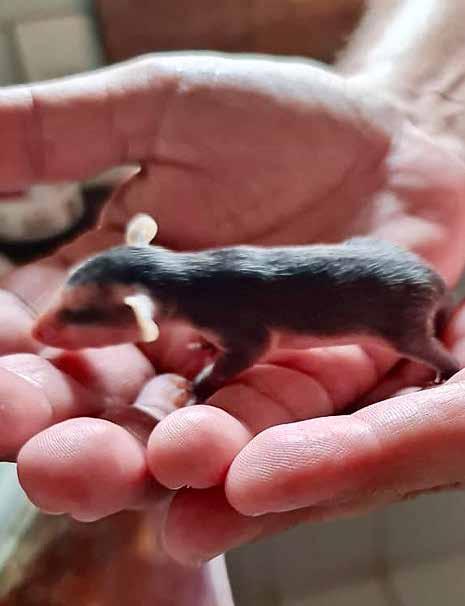
2022 december volume two © liveencounters.net
02 Julia, photograph by José Truda Palazzo, Jr.
© José Truda Palazzo,
Jr. J O S É T R U D A P A L A Z Z O, J R.
Their presence in our lives fill our hearts with joy, a feeling I rediscovered in the presence of these humble beings after so many decades fighting for conservation of other, faraway species. May you who read me now also be able to find joy in the small creatures that share our surroundings, and who only appeal to the most human of all our traits - kindness - to continue existing in peace.
To this day we’re convinced it was an illegal attempt at harassing and embarrassing us so we would shut up). Many volunteers in different countries suffer the same persecution and harassment, and protecting them from abuse is paramount if we want injured urban wildlife to have a fighting chance.
As I write these lines, dusk settles around our little backyard, and the singing birds and quarreling marmosets vacate the feeder for the opossums that will soon arrive with the night. In their little wooden boxes, our furry orphans wake up for another night of roaming the house, playing, feeding, and returning to a safe and cozy shelter afterwards, little lives that became so important for us that my wife decided to start a nationwide movement to educate about opossums and improve their protection. Their presence in our lives fill our hearts with joy, a feeling I rediscovered in the presence of these humble beings after so many decades fighting for conservation of other, faraway species. May you who read me now also be able to find joy in the small creatures that share our surroundings, and who only appeal to the most human of all our traits - kindness - to continue existing in peace.
©liveencounters.net volume two december 2022 Celebrating 13th Anniversary
U R B A N W I L D L I F E
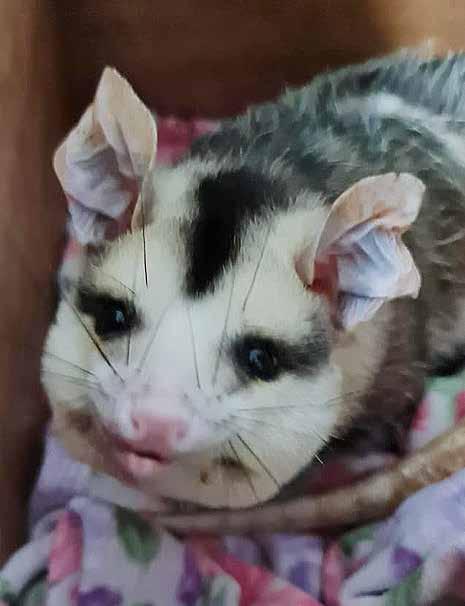
2022 december volume two © liveencounters.net
03 Julia, photograph by José Truda Palazzo, Jr.
J O S
U
J R.
© José Truda Palazzo, Jr.
É T R
D A P A L A Z Z O,

©liveencounters.net volume two december 2022 Celebrating 13th Anniversary T E D D Y A N D B R Y A N
Katie Costello
Katie Costello was born and raised in Hubbard, Ohio, USA. Her greatest passion in life has always been to help animals. She is lucky enough to be a licensed veterinary technician and owner of The Canine Campus Training and Wellness Center and The Canine Campus Bed and Biscuit Inn, where she helps animals through behavior work, does training of all types including aggression, fear, and service dog work. A vegetarian since she was 6 years old and a vegan for the last 15 years, she currently has 7 dogs, 5 cats, 7 chickens, 3 roosters, 1 very special turkey and 2 farm pigs that are amongst her dearest friends. She is founder of 2 non-profit organizations, K-9’s for Compassion (Co-founded with her father), a therapy animal group and The Together 3 Journey, a service dog organization. She has been on the board of many animal organizations throughout her life, including Happy Trails Farm Animal Sanctuary and C.H.A.I.N. (Community Helping Animals In Need) and SVBT (Society of Veterinary Behavior Technicians) She enjoys freelance writing about (mostly) animals for different magazines, with her favorite being Live Encounters! https://thecaninecampustraining.com/
Katie Costello Teddy and Bryan: A Boy and His Dog
Everyone has amazing days that they will never forget, usually inspired by something wonderful being done for them, or something wonderful they are doing. One such day in my life was January 14, 2001, and the few months that would follow.
I awoke one cold, snowy morning and decided to check my emails. I started a therapy dog group in Youngstown, Ohio area called K-9’s for Compassion and belonged to a virtual group for therapy dogs. The list commonly spreads tips and tricks for when visiting with your animal. Interestingly, on that fateful day there was a misguided message that grabbed my interest. It was from a mother in New Jersey; her son, Bryan, was terminally ill, and she was looking for a golden retriever that he would name “Teddy”.
2022 december volume two © liveencounters.net
K A T I E C O S T E L L O
© Katie Costello
At first, it struck me as bizarre that this message even made it onto the group’s page. This is a group of people that already have dogs, and most have already tested through one of the national registries.
Then, I started to think, “I can do this”!
My first concern was that I was going to place a dog in a good home; a home where the dog would have the best possible life. I needed to be certain this home would be for the life of the dog. I wanted to find out as much as I possibly could about them, Bryan, his mother, their lifestyle, and their dog knowledge. I contacted Bryan’s mother, Karen, and asked for her email address; I sent a four-page application quizzing her about every aspect of their lives. Within a few days, I received the application back along with a letter. The letter explained how Bryan has cystic fibrosis, seizure disorder, and ADHD. Bryan had two wishes to Make-A-Wish foundation: The first was for a golden retriever and the second was to go to Disney and swim with the dolphins. Make-A-Wish foundation sent him to Disney World, and his mother was trying to figure out a way to grant his second wish.
I went through the references she sent to me and called them. One of my concerns was that Bryan possibly shouldn’t even have a dog, so I called his physician who said that a dog might be the best thing for him! My first thoughts were to go to a golden retriever rescue group to get him a dog, work on some basic training, then drive him from Ohio to Bryan in New Jersey. However, one of the members of my therapy animal group was a golden retriever breeder and worked with a local golden retriever rescue, so I started there. Much to my surprise Vonnie Peterson said she would donate one of her puppies to this little boy. We were elated by the prospects of his wish really coming true!
We waited for her next litter of puppies and Vonnie handpicked a male from the group, which is specifically what Bryan wanted. He was a big, sturdy boy, and Bryan had already named him Teddy. I made the decision that Teddy would be neutered before he ever left the area. My now husband, Dr. Samuel Costello, of Town and Country Veterinary Hospital in Warren, Ohio agreed to do the surgery for me at no cost. He was neutered, and we gave him a few days to recover.
We decided that May 26, 2001 would be the day that we would make the drive to take Teddy to Bryan. Several friends were anxious to be part of the fun. We decided to make a whole day of it and go to New Jersey and deliver Teddy then head into New York City for a little fun before driving home.
©liveencounters.net volume two december 2022 Celebrating 13th Anniversary
T E D D Y A N D B R Y A N
The night before we left, the local media caught wind of the story, and we were bombarded by every news station and newspaper in our area. It was wonderful to have them taking pictures of Teddy and wishing us well. People continued to come to my house to drop off more toys and food that evening. It was truly a community coming together for this little boy and this terrific story! The story was bigger than I could have imagined!
I went to a local pet store and asked if they would donate any items to go with Teddy. Pet Supplies Plus donated many items including a big bag of food, a collar and leash, a big dog bed, some bones and treats, toys, and a large food and water stand. They gave us everything a dog could need! We loaded them into the car for our soon to be journey. Being a huge fan of both authors Jack Kerouac and John Steinbeck, I couldn’t help but compare the trip to “On the Road” or “Travels with Charley”. What fun!
The night before we left, the local media caught wind of the story, and we were bombarded by every news station and newspaper in our area. It was wonderful to have them taking pictures of Teddy and wishing us well. People continued to come to my house to drop off more toys and food that evening. It was truly a community coming together for this little boy and this terrific story! The story was bigger than I could have imagined!
We woke up at 3:00 AM to leave. Teddy rode very well in the car; little did he know he was going to have a big role when he arrived in New Jersey. We all talked the entire eight-hour drive about how awesome it would be to see this story finally unfold and see the look on Bryan’s face. We had made a banner to put across the back of the car that said “Teddy is making his way to his forever home with Bryan in N.J.” We arrived in New Jersey about 12:00 PM.
When we pulled up to the house, there were several children in the street and a golden retriever flag hanging. I was certain this was the right house! We stepped out of the car, and I said, “Which one of you is Bryan?” One boy stepped up and said, “I am Bryan!”, so I pulled Teddy out of the car. Screams of joy came from Bryan as he ran to his new puppy, grabbing him and hugging him tightly to his chest. Karen walked out of the house and tears filled everyone’s eyes. Bryan walked with Teddy over to the grass and began rolling on the ground and playing with him. We were all snapping pictures and New Jersey media started to arrive. This was one famous puppy!
Karen had made a lot of food for everyone. We walked into the house, and there was Teddy’s large crate with more toys and more food. This was already one much loved puppy! We talked to the media, Bryan, and Karen. It was an overwhelming day, emotionally and physically, but one that I wouldn’t have changed for the world.
2022 december volume two © liveencounters.net
K A T I E C O S T E L L O
© Katie Costello
We stayed for several hours visiting and letting them get to know Teddy. When it was time to leave, Karen and Bryan both said tearful goodbyes. Sometimes strangers aren’t strangers at all. Sometimes it is like you have known each other for a lifetime. As we were leaving, Bryan and Karen were running down the street waving goodbye. I watched in the rear-view mirror as they faded into the distance. Somehow, I knew that this wouldn’t be the end of the Teddy story!
Karen and I keep in contact, even to this day, but at the beginning we talked nearly weekly. Teddy grew into a beautiful adult dog, the best dog in the world, as they reported to me. When Bryan isn’t feeling well, Teddy lays next to him until he feels better. When Bryan is in the hospital, Teddy cheers Karen up. They both report loving this dog so much and say that he has made their lives complete. A mom, a boy, and his dog have all found a deeper love that extends beyond human understanding.
And so, off in the evening light of a New Jersey May day, we drove into New York city with smiles on our faces, a story that has proven to follow us everywhere, and imprints of a great dog and family in our hearts.
Karen and Bryan mailed me a big photo album filled with Bryan and Teddy and their adventures since May 2001 when Teddy arrived. The album proved that Teddy indeed had had a great home. He went everywhere with them, and he had more toys than most children! The photo album brought back a whirl wind of memories of that happy day and the pride I have from being able to be part of making a wish come true.
Sadly, in 2013, Teddy was diagnosed with cancer and even though they tried everything, nothing could save him. It was so sad to hear and heartbreaking to not be able to do more. After several years, they were able to see only the happy memories. I am sure Teddy is sitting at the rainbow bridge waiting to reunite with his family. As for Bryan, he is doing as well as he can be, as has many hospital visits. To this day, he misses Teddy tremendously.
©liveencounters.net volume two december 2022 Celebrating 13th Anniversary T E D D Y A N D B R Y A N
Photograph: https://pixabay.com/photos/dog-puppy-golden-retriever-breed-4372036/

2022 december volume two © liveencounters.net © Katie Costello K A T I E C O S T E L L O

©liveencounters.net volume two december 2022 Celebrating 13th Anniversary I R E L A N D
Tina Claffey
Tina Claffey is an award-winning Irish nature photographer and author of ‘Tapestry of Light-Ireland’s bogs & wetlands as never seen before’ released in October 2017, and now her new book has just been published, ‘Portal-Otherworldly Wonders of Ireland’s Bogs, Wetlands and Eskers’. Her observations and unique perspective through her macro lens of the flora and fauna of the raised bogs and wet woodlands of the Irish midlands are celebrated in her work. She has exhibited in group shows in the US, Botswana, Zambia and has had solo exhibitions throughout Ireland. Her work is part of many art collections, permanent exhibitions, including the permanent collection at Áras an Uachtaráin, home of the Irish President. She has presented her work on many worldwide online platforms including the Wildlife Habitat Council Online Conference in the US and the UN Climate Change Conference (COP 26) to promote the importance of the Irish bog wilderness. https://www.tinaclaffey.com/
Tina Claffey Ireland’s miniature winter bog wilderness
Photographs
I love to get ‘lost’ in the bogs, eskers and wetlands of Ireland with my macro lens throughout the seasons.
The macro lens allows me to capture what cannot be seen by the naked eye, and capture scenes that defy our sense of reality, glimpses of other miniature worlds that co-exist with us.
One would imagine that in Winter, there wouldn’t be much to see out there, but the Winter wilderness in the bog is truly magical. As the sun stays low in the sky all day, it is ‘golden hour’ all day!
The Winter frost casts a magical frosted spell on the flora & fauna, and the living carpet twinkles with delight.
Frosted sphagnums emerge like giants, caterpillars roam the scarlet Devil’s Matchstick lichens seeking Winter shelter. Spiked shieldbugs hunt for remaining insects deep in the heather, while Haircap mosses emerge like fireworks deep in the wet woodland. Wild Carrot entice us to drink from its frosted chalice, and the early morning sun illuminates mysterious jelly fungus, as the bark of the birch trees peel away. Otherworldly Reindeer lichen reveal their fruit spores, and the Furze bushes reveal their golden flowers.
© Tina Claffey
© liveencounters.net T I N A C L A F F E Y
2022 december volume two

©liveencounters.net volume two december 2022 Celebrating 13th Anniversary
I R E L A N D
Devil’s Matchstick Tree

2022 december volume two © liveencounters.net
T I N A C L A F F E Y
Sphagnum Ice Giant
© Tina Claffey

©liveencounters.net volume two december 2022 Celebrating 13th Anniversary
I R E L A N D
Wild Carrot Frosted Carrot

2022 december volume two © liveencounters.net
T I N A C L A F F E Y
Tina
Spiked Shieldbug
©
Claffey
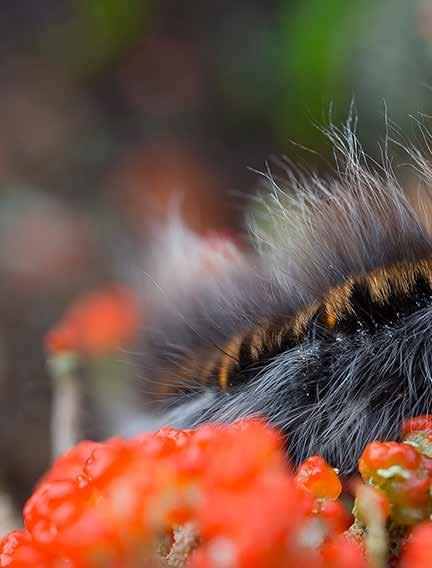
©liveencounters.net volume two december 2022 Celebrating 13th Anniversary
I R E L A N D
Foxmouth catepillar amongst Devil’s Matchstick Lichen

2022 december volume two © liveencounters.net T I N A C L A F F E Y
© Tina Claffey
Reindeer Lichen Apothecia

©liveencounters.net volume two december 2022 Celebrating 13th Anniversary
I R E L A N D
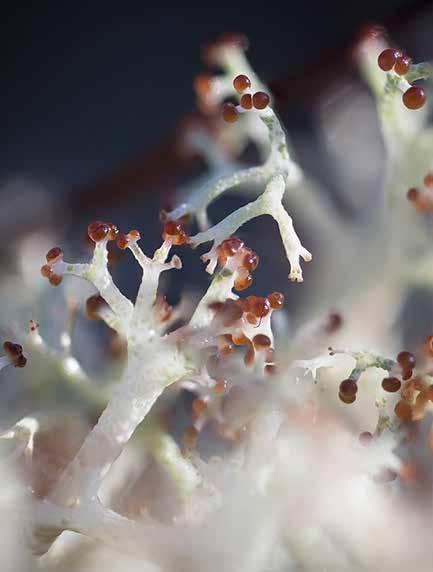
2022 december volume two © liveencounters.net T I N A C L A F F E Y
© Tina Claffey

©liveencounters.net volume two december 2022 Celebrating 13th Anniversary
I R E L A N D
Haircap Moss

2022 december volume two © liveencounters.net T I N A C L A F F E Y
© Tina Claffey
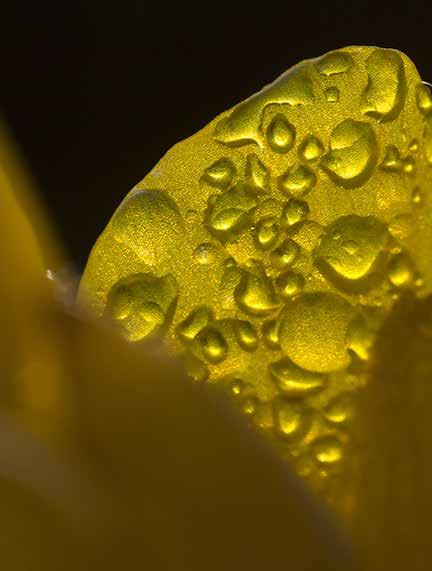
©liveencounters.net volume two december 2022 Celebrating 13th Anniversary
I R E L A N D
Furze Morning Dew

2022 december volume two © liveencounters.net T I N A C L A F F E Y
© Tina Claffey

©liveencounters.net volume two december 2022 Celebrating 13th Anniversary S T I L L L I F E
Wolfgang Widmoser
Born in Munich 1954. 1973 studied with Ernst Fuchs and Salvador Dali. 1970 he painted still-lives in Switzerland introducing curved mirrors which reflect objects in most surprising ways and led to a proposal for the –elegant Universe. Moving to Toscany in 1980 landscape and atmospheric effects crystallized to intense, portraits of nature. Since 1984 living in Bali. In his search for the- abstract. Papua New Guinea – Warriors combine the archaic with the futuristic. Wolfgang’s motto – aesthetic = ethic – points to places where humans experience the Good, the True and the Beautiful.
Wolfgang Widmoser
Still lifes
Artwork
A still life is an arrangement of objects on a table. A painting is an arrangement of colored brushstrokes on a canvas. The objects contain a specific energy. When flooded by light they are clearly visible to the observer. Contemplating their shapes certain qualities are revealed. A story emerges as the individuals start to interact.
- Look at me – the marble exclaims – the light concentrates in my heart and gets reflected on my skin as I mirror the sun- I unfold like a galaxy – the shell is singing – and my skin is filled with diamonds –sending flickering rainbows across my surface –The plate is resting in woven fabric with intriguing patterns and dreams – I am the garden of Eden A playground for all my visitors - a shell in a plate –- a baby in a womb –- a galaxy in the universe –
2022 december volume two © liveencounters.net W O L F G A N G W I D M O S E R
© Wolfgang Widmoser
Broken shell in a red bowl - oil on canvas - 90x75cm

©liveencounters.net volume two december 2022 Celebrating 13th Anniversary
S T I L L L I F E
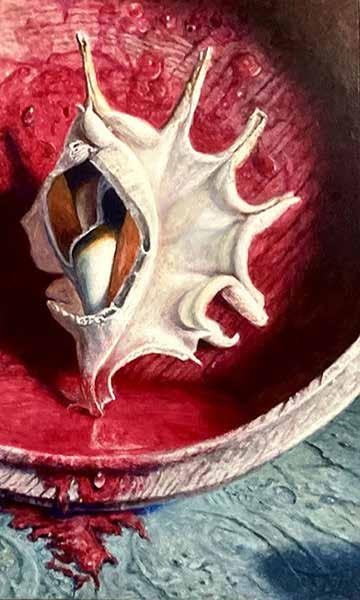
2022 december volume two © liveencounters.net W O L F G A N G W I D M O S E R © Wolfgang Widmoser
Shell in a blue plate - oil on canvas - 150x120cm

©liveencounters.net volume two december 2022 Celebrating 13th Anniversary
S T I L L L I F E

2022 december volume two © liveencounters.net W O L F G A N G W I D M O S E R © Wolfgang Widmoser
Nautilus in a blue plate - oil on canvas - 150x120cm

©liveencounters.net volume two december 2022 Celebrating 13th Anniversary
S T I L L L I F E
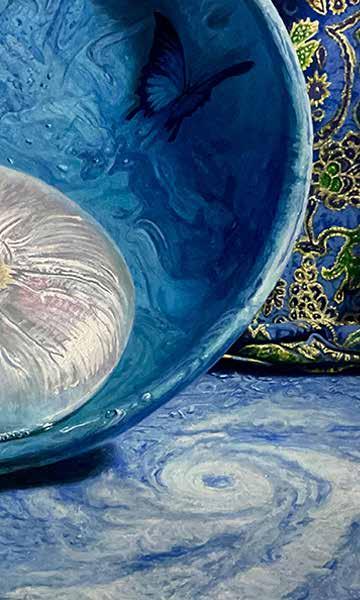
2022 december volume two © liveencounters.net W O L F G A N G W I D M O S E R © Wolfgang Widmoser
Shell in a golden plate - oil on canvas - 150x120cm

©liveencounters.net volume two december 2022 Celebrating 13th Anniversary
S T I L L L I F E

2022 december volume two © liveencounters.net W O L F G A N G W I D M O S E R © Wolfgang Widmoser

©liveencounters.net volume two december 2022 Celebrating 13th Anniversary
S T I L L L I F E
Nautilus in a golden plate - oil on canvas - 90x75cm

2022 december volume two © liveencounters.net W O L F G A N G W I D M O S E R © Wolfgang Widmoser
Shell in an offering bowl - oil on canvas - 150x120cm

©liveencounters.net volume two december 2022 Celebrating 13th Anniversary
S T I L L L I F E

2022 december volume two © liveencounters.net W O L F G A N G W I D M O S E R © Wolfgang Widmoser
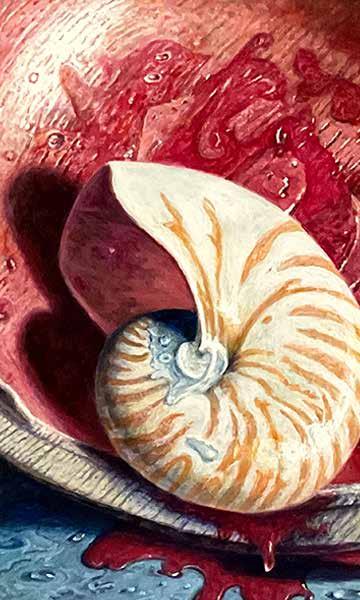
©liveencounters.net volume two december 2022 Celebrating 13th Anniversary
S T I L L L I F E
Nautilus in an offering bowl - oil on canvas - 90x75cm
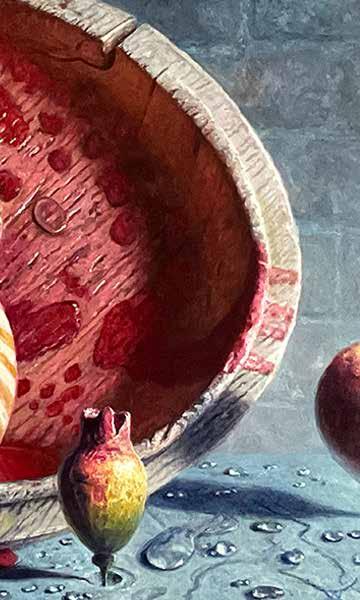
2022 december volume two © liveencounters.net W O L F G A N G W I D M O S E R © Wolfgang Widmoser
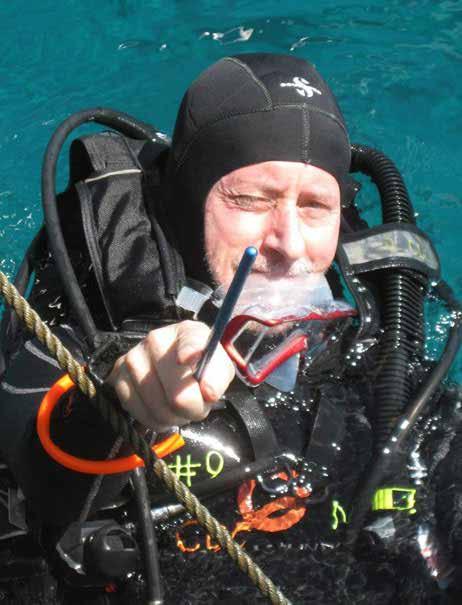
©liveencounters.net volume two december
C O R A L R E E F
2022 Celebrating 13th Anniversary
Tim Tomlinson. Photograph by Deedle Tomlinson.
Tim Tomlinson is the author of the chapbook Yolanda: An Oral History in Verse, the poetry collection, Requiem for the Tree Fort I Set on Fire, and the short story collection, This Is Not Happening to You. Recent work appears in The Antonym: Bridge to Global Literature, Beltway Jerry Jazz Musician, Lighthouse Weekly, and the anthology, Surviving Suicide: A Collection of Poems that May Save a Life. He is the director of New York Writers Workshop, and co-author of its popular text, The Portable MFA in Creative Writing. He teaches writing in NYU’s Global Liberal Studies.
Tim Tomlinson Death, Sex, and Transition on the Coral Reef
Death
In Roatàn, Honduras, they say every dive is a wall dive, and that’s true at least on the lee side. There, the fringing reef begins a few meters from shore. I walk in geared up, slip into fins, and deflate my vest in less than five feet of water. I belly down over a wide swath of turtle grass divided by something that resembles a footpath—a narrow white-sand furrow that could very well be the result of foot traffic (dive booty traffic). But I’m a Pacific diver, an Indo-Pacific diver, and I don’t like taking steps on any surface near a reef, booties or no. Venomous creatures might, and often do, lurk unseen in the sand or the rubble, especially the sand and the rubble that look like there’s nothing lurking there at all, and dive booties, no matter how thicksoled, don’t offer sufficient protection.
Once, in Coron near Palawan in the Philippines, I saw a young man, eighteen or twenty, wading around in crystal clear water up to his waist. He took a step, exclaimed, then sat down. In the few hours of his life that remained, he never took another step. I read about it the next day. No one knew what happened, not even the kid. EMT workers didn’t remove his booties until they’d wheeled his gurney onto the airport tarmac, not that it would have mattered, since Coron (at that time) did not maintain a supply of antivenoms. In the sole of his foot were signs of envenomization from the dorsal spines of a stonefish. [1]
© Tim Tomlinson
2022 december volume two © liveencounters.net T I M T O M L I N S O N
He was flown to Cebu for antivenoms, but it had taken close to two hours just to get him on the plane, at which point he’d already gone comatose. What was doubly sad was that the young man was off on a tryst—his first—with a lover, an older man, his literature professor. They had chosen Coron to be as far as possible from anyone who might recognize them; they were from Baguio, up north, where the kid was not out, at least to his family. On TV news footage, the professor, in tears, proudly proclaimed their forbidden love. I don’t know why these kinds of stories cross my mind every time I enter the water, but in a way, I’m glad they do—they make me extra cautious, not necessarily a bad thing to be, and they intensify the experience: each dive survived, no matter how ordinary, becomes a tale to tell.
Now I’m in twelve feet of water, my belly inches above the grass blades, taking my time getting out to the wall. A lot of divers hustle right over the grassbeds. They completely miss an environment rife with diversity, rife with life. As are the stretches of rubble and sand, the lesson that unfortunate young man learned the hard way. Here in the turtle grass I find urchins covered with roe, juveniles puttering among the grass blades, shrimps the size of fingernails and smaller, coin-sized crabs with pincers raised, ready to do battle, an ocellated moray[2] poking its head under empty shells. And just ahead, where the seabed begins to slope and the blue turns a darker shade, I see something shining, something that appears irradiated from within. Instantly I know what it is—something I’ve looked for dozens of times and found only once, off Coron. A star anemone[3], transluscent as cellophane, perched like an ornament atop a Christmas tree right at the tip of a grass blade, its fingers noodling for nutrients in the water column. From its central disc, the size of a quarter, a ray of light shone—which, I knew, wasn’t possible in the scientific sense of things.
No anemone of any kind generates light. What I was seeing resulted from sunlight refracted at the surface, one of the rays finding the very center of this creature and setting it aglow. Genetically, the anemone is nearly identical to a coral polyp, but the experiential differences of the two animals are significant: the anemone lives alone—it does not dwell within colonies; and it’s exposed, often completely—it neither creates nor inhabits the limestone structures that serve as the protective exoskeletons of corals. This anemone—exposed, alone, and isolated as a star in the night sky—is, I decide, the sea’s tribute to that unfortunate young man who’d stepped on the stonefish.
©liveencounters.net volume two december 2022 Celebrating 13th Anniversary
C O R A L R E E F
Photograph: https://pixabay.com/photos/parrot-fish-fish-underwater-water-2793638/
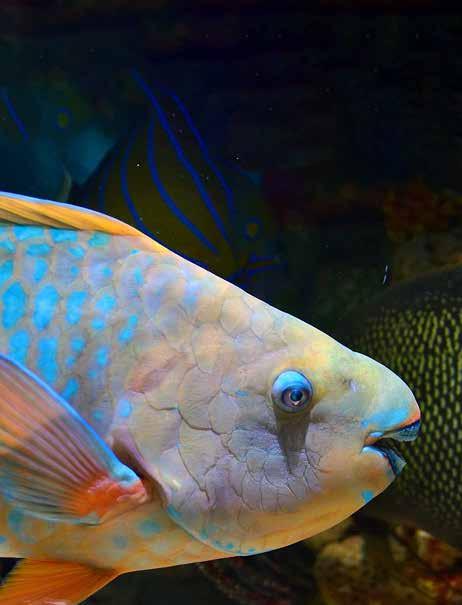
2022 december volume two © liveencounters.net T I M T O M L I N S O N
© Tim Tomlinson
Of course, that’s an association utterly divorced from science, but there’s so much that goes on down here in this informal laboratory that’s not science, so much that occurs only in the diver’s mind, my mind, that nebulous entity that often feels inseparable from the sea, its majesty and its meaninglessness. I observe the anemone for many minutes, its translucent tentacles fluttering in the ebb and flow. One of them snags something from the stream, something planktonic, and the arms contract toward the oral rictus. The Delmore Schwartz line occurs to me: The scrimmage of appetite everywhere. But sometimes it’s not even appetite. Sometimes what happens lacks even that base meaning. I think of the young lover who sat down in the shallow water, the professor holding him by the armpits, calling for help, and later, the professor’s face in the newspapers, soaked with tears. What appetite did that serve: the kid’s body, his life, his partner and his family’s grief, a complete waste. I’m not a religious man, but I know a few prayers, a few chants. Gate gate paragate parasamgate bodhi svaha. A few lines from Leonard Cohen songs.
For me, the anemone is the most magical, the most numinous creature. No eyes, no ears, no sense of smell, just arms, mouth, and a digestive tract. Hunger. In that, the anemone and I are simpatico. I wish it could be vegetarian, but fine. If it were, there might not be any turtle grass to perch on, to hide in, and I might not have had this evocative encounter. When I move on, the light has changed, the rays are more slanted. I descend the slope, a journey from pale blue to an inky supersaturation, from robin’s egg to navy—red disappears at fifteen feet—and reach the wall. I hover there in the traffic of chromis and wrasse and stare down into the fathomless blue, the abyss that’s come to feel more and more like a home. There’s probably a way to mind-meld with blue, to silence the monkey mind and conjoin with it the way a monk sitting lotus in a field becomes the field. I don’t know how to do it, but sometimes when it’s almost happening—that near total suspension of self—I catch myself. I’m afraid that when it happens, if it ever happens, it will be the last thing that happens, and that’s something I don’t feel ready for, nor will I be for for a very long time, if ever.
On my return to shore, I look for the star anemone but amidst all the nearly identical grass blades, I can’t find it. Maybe it’s moved on. I hope it’s moved on. Because even here in the grassy shallows so close to shore, the sea is alive with predators. And predators don’t care about glowing tributes, or young dead lovers two oceans away.
©liveencounters.net volume two december 2022 Celebrating 13th Anniversary
C O R A L R E E F
What ensued was like the Dance of the Seven Veils, shark after shark after shark making loops on and around and over each other, all within the space of the grotto. They were belly to back, belly to belly, face to hind-quarters, around and about and through each other, gliding and sliding and looping like figures slick with oil in a Roman orgy. And the light so dramatic—shades of brown so dark they were almost black, back- and top-lit like a Rembrandt, with this radiant golden light illuminating the gray-brown trunks of the bodies, the white bellies, and the faces all twisted up like the horses of Picasso.
Sex
In New York, where I live, I’ve seen a lot of fucking. Pigeons, of course, on fire escapes and rooftops and in the parks. And dogs, in the dog runs, on the sidewalks, sometimes right alongside their owners who blithely carry on conversations with their cell phones while their pets get to know each other. In Morningside Heights I had a neighbor, a Polish girl, whose bedroom window was blindsless and just opposite my own across the alley. She entertained a rotation of at least six partners, each more bald than the last (balding men, take hope!). I recognized one. He had a recurring role in an HBO series concerning corruption in Washington, but in that role he wore a toupee. I didn’t scrutinize my neighbor’s trysts, as such, but I admit I looked probably longer than I should have. She was quite attractive, this Polish girl, and her lifestyle was, well, inspirational. And wouldn’t you look, too, if absent-mindedly one morning you happened to raise your blinds and there she was, hardly more than an arm’s length away, going at it without a spark of modesty as though she were a performance artist at an exhibition? I mean, I look at pigeons, of course I was going to look at her. But that’s all on land. Underwater, acts of public affection have not been as ubiquitous.
Once, near Malapascua, I entered a tunnel on the side of Gato Island, an uninhabited stone in the Visayan Sea. The tunnel became lightless a short way in, but up ahead twenty or so feet, a play of light appeared. There must have been a crack somewhere on the island’s surface. I proceeded toward the light and there, in a stone grotto that had the appearance of a diorama at the Museum of Natural History, nearly a dozen reef sharks, white tips, slept or rested one on top of the other. When they sensed my presence (it’s hard to hide underwater when you’re blowing bubbles) they became quite agitated. What ensued was like the Dance of the Seven Veils, shark after shark after shark mak ing loops on and around and over each other, all within the space of the grotto. They were belly to back, belly to belly, face to hind-quarters, around and about and through each other, gliding and sliding and looping like figures slick with oil in a Roman orgy. And the light so dramatic—shades of brown so dark they were almost black, back- and top-lit like a Rembrandt, with this radiant golden light illuminating the gray-brown trunks of the bodies, the white bellies, and the faces all twisted up like the horses of Picasso. Unlike my Polish neighbor, the sharks engaged in no sexual behavior, but I had the distinct feeling of having compromised an intimate scene and I stared, in awe, for well over five minutes, at which point I thought either their hearts or my air would expire.
2022 december volume two © liveencounters.net T I M T O M L I N S O N
© Tim Tomlinson
Here transitioning is unremarkable and not uncommon. Reef dwellers have no problem with it. They don’t waste time dwelling on it. Think of it: how could they? In many species, the anemone for instance, the anus is the mouth—talk about shitting where you eat! And if that’s your anatomical situation, how are you going to mount a credible critique of your neighbor’s habits, no matter how debased?
The only actual fucking I’ve seen underwater occurred with a much smaller species: the lettuce sea slug. These are, essentially, snails without the shell about the size of a child’s thumb. This pair was green and white, crinkly little things you could imagine in your salad. Their copulation took place on a blighted boulder of brain coral shadowed by soft fans and sea rods bending in mild current. And, if I had my genders correct, quite conventional it was. He mounted her, not missionarily but from behind in what Henry Miller liked to call “back-scuttling.” I’m reminded that when teaching English to a group of bored French boys, Miller introduced lectures concerning the physiology of love among our friends in nature, which culminated, evolutionarily speaking, in the “whale with his six foot penis.” On this sea slug Romeo I could discern no such appendage, even with my mask just inches from his passion and my camera on macro, but I will say this for him: he gave his partner what I’m sure she regarded as a full and proper treatment, sliding slowly and deliberately from the rear tip of her leafy self, over the dorsal cerrata and rhinophores right up to and over the oral tentacles, where he detached and lifted off, then bellied down the coral slope, presumably to find some algae or plankton to nosh. He had performed; an appetite had been raised. She remained in place, in position, as it were, like an aloof odalisque running an emery board across her nails. Moving on, I noticed another lettuce sea slug making its way down the fan. And another. Males of the species, I deduced, and thought again of my Polish neighbor and her hairless suitors. The scrimmage of appetite everywhere.
Transition
I don’t know what to think about a former girlfriend who’s transitioned. She was taller than me by several inches—that’s not a difficult or even a masculine achievement: at my modest height, I’ve had to stand on footstools to kiss lots of girlfriends. This one I remember as particularly vital. Une vrai femme, is the French phrase I believe—so much woman packed into her native skin. I may have been supplying those impressions—she was younger by quite a few years, a fact, and a condition, that I found stimulating. In the end, she felt that I’d wronged her emotionally, psychologically. She started working in adult films and sent me screen shots of various degrading scenarios. Then she began writing. She wrote about my abuse of her, my manipulation. She blamed me for the trauma that drove her into pornography. She tried to destroy me professionally, politically.
©liveencounters.net volume two december 2022 Celebrating 13th Anniversary
C O R A L R E E F
End Notes:
[1] Size: up to 14 in. ID: Globular and poorly defined shape, appear as algae-covered stone. Venomous spines deadly; may bury in sand. (Gerald Allen, Roger Steene, Paul Humann, Ned DeLoach, Reef Fish Identification: Tropical Pacific.)
[2] Size: 14-20 in. Habitat and Behavior: Inhabit seagrass and sandy areas with algae and other plant growth. Forage in open during the day. Reaction to Divers: Appear unconcerned; usually allow a close approach. (Paul Humann, Ned DeLoach, Reef Fish Identification: Florida, Carib bean, Bahamas.)
[3] Size: disc to 2 cm (¾ in). ID: translucent tentacles most commonly extended at night. Attach to seagrass blades. (Paul Humann, Ned DeLoach, Reef Creature Identification: Florida, Caribbean, Bahamas.)
[4] Size: to 48 cm. ID: Green with pink to lavender scale edges. Habitat: fringing reefs, lagoons and outer slopes, 3-35 m. (Gerald Allen, Roger Steene, Paul Humann, Ned DeLoach, Reef Fish Identification: Tropical Pacific.)
She called me the most resourceful player (she’d written “playa,” which at first I interpreted to mean “beach”) she’d ever encountered. Now she is a he. S/he looks butch. S/he looks biker, a ringer for S. Clay Wilson’s cartoon virago, Ruby the Dyke. Nowhere in evidence the generator of hot electric current that once had fused us at the sockets.
These reflections occur to me at a fringing reef off Koh Thao, Thailand, a nation where numerous la dyboys with exquisite bodies and unfortunate Adam’s apples present on street corners, pool halls, and night clubs. I’m watching a young parrotfish work the reef. Today the parrotfish [4] is female, her predominant coloring brick red to dark brown. She is doing what parrotfish of both sexes do: chew ing on corals and sponges, excreting clouds of sandy waste. An immodest species, perhaps, female or male, but then all fish are. Next week, or next month, or next year if she’s lucky enough to live that long, she will be male, a he—unless she insists on a non-gendered pronoun. She will have tran sitioned, and she will have changed coloring to the predominantly aqua-green of the fully mature parrotfish. It’s a process known as protogynous hermaphroditism, of which the parrotfish is by no means the only practitioner among citizens of the reef.
Here transitioning is unremarkable and not uncommon. Reef dwellers have no problem with it. They don’t waste time dwelling on it. Think of it: how could they? In many species, the anemone for instance, the anus is the mouth—talk about shitting where you eat! And if that’s your anatomical situation, how are you going to mount a credible critique of your neighbor’s habits, no matter how debased? It’s a kind of gift, this collective affliction, one might call it, but really it’s just a state of being. No one’s hung up, no one thinks, oh, if she’s now a he, does that mean I’ve fucked a man, many times, crazily and with wild abandon? And if so, what does that mean in the big picture of my gender identity? The female parrot lifts from the coral, lets out a fecal cloud—I love the way she looks right at me when she evacuates, like, what, you got a problem? Again, S. Clay Wilson’s Ruby comes to mind. She settles at the base of a purple tube sponge, beaking grooves into the algae. If she continues to eat well, to avoid traps and hooks and predators, she will become big man on the reef, where s/he will continue to eat and excrete and avoid predators, and not once will s/he stop to think, what are my pronouns, and who’s the one responsible for the decisions I’ve made, the transitions I’ve undertaken?
2022 december volume two © liveencounters.net T I M T O M L I N S O N
© Tim Tomlinson

©liveencounters.net volume two december 2022 Celebrating 13th Anniversary P A I N T O G R A P H Y
Carl Scharwath
Carl Scharwath, has appeared globally with 175+ journals selecting his writing or art. Carl has published three poetry books and his latest book “Playground of Destiny” features poetry, short stories and photography (Impspired Press) His two photography books were published by Praxis in Africa. His photography was also exhibited in the Mount Dora Center and The Leesburg Center for The Arts. Seven global poets have selected his photography as their book covers. Carl was the art editor for Minute Magazine (4 years,) is a contributing editor for ILA Magazine. He was nominated for two The Best of the Net Awards (2021-22) and his paintography/poetry were featured in a 2022 Showcase with Valiant Scribe. He is also a competitive runner, and a 2nd degree black- belt in Taekwondo.
Carl Scharwath Paintography artwork
I use photography as a means of self-expression. The most important quality of a photograph, as in all art, is to evoke an emotional response. I prefer to capture surrealistic moments when I can, the play of light and colors and unusual situations as they unfold. As a passionate runner, being aware of my surroundings tends to produce some surprise scenes instead of forcing an image of time with my camera. Currently I have been concentrating on collaborations with other international poets who interpret my photos with their powerful words creating an art form that compliments each other. I am also exploring and creating works which combine my painting and photography.
© Carl Scharwath
2022 december volume two © liveencounters.net C A R L S C H A R W A T H

©liveencounters.net volume two december 2022 Celebrating 13th Anniversary Childhood
P A I N T O G R A P H Y
Dreams

2022 december volume two © liveencounters.net C A R L S C H A R W A T H © Carl Scharwath
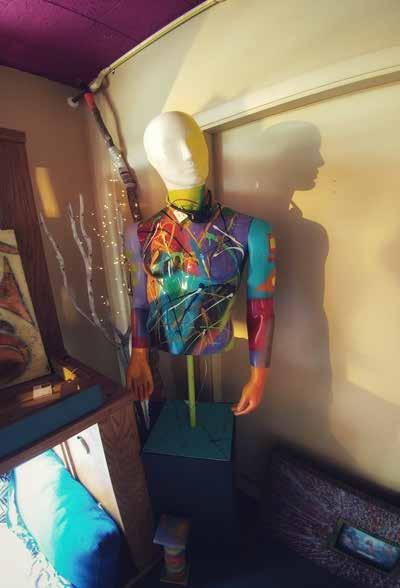
©liveencounters.net volume two december 2022 Celebrating 13th Anniversary P A I N T O G R A P H Y
Modern Man
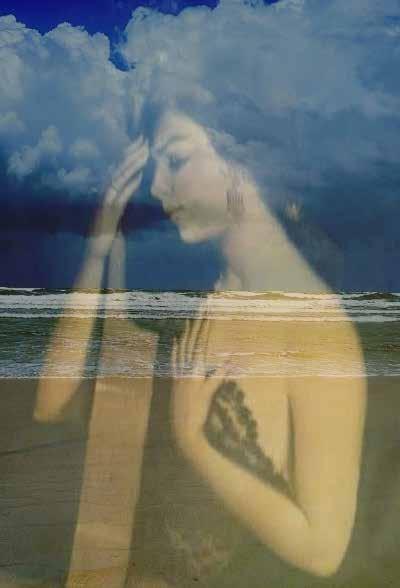
2022 december volume two © liveencounters.net
C A
A R W A T H © Carl Scharwath
Aurora (this was my oil painting with ocean photography)
R L S C H

©liveencounters.net volume two december 2022 Celebrating 13th Anniversary P A I N T O G R A P H Y Store Window Sappho

2022 december volume two © liveencounters.net
C A R L S C H A R W A T H © Carl Scharwath
Made of Glass
Phosphenes

©liveencounters.net volume two december 2022 Celebrating 13th Anniversary P A I N T O G R A P H Y

2022 december volume two © liveencounters.net
C A R L S C H A R W A T H © Carl Scharwath
Antique Store Garden

©liveencounters.net volume two december 2022 Celebrating 13th Anniversary N A T U R E
Afaf Elbousty
Afaf Elbousty is a freelance writer, translator, and photographer. She was born in Casablanca, Morocco where she spent more than two decades before she moved to the U.S. She previously worked in the banking industry in Morocco, where she played a key role in many banking initiatives. Upon her arrival to the U.S., she has been involved in many initiatives, including freelance work and photography. She is an avid reader; she spends most of her time outdoors, capturing riveting photographs. She has an Instagram account (@afafelboustyphotography) where she features her photography.
Afaf Elbousty Nature is the answer
Photographs
Nature is simply a masterpiece; a glimpse of what heaven looks like. I always feel honored and at peace when I take my camera out and capture some aspects of it. I’ve always been told that the best photographs I take are of animals and nature.
I find this practice very therapeutic and inspirational; it makes me very happy and proud of what I do. Life is full of wonders and details that are easily missed if you don’t take a closer look. When I take a photo, I try to immortalize a moment that is otherwise gone forever. Nature has the power to heal souls, reconnect us to our origins, and make us understand the purpose of life. We cannot survive a day without nature, and it truly amazes me. Nature is silent yet so loud in its actions. Every breath we take, the food we eat, the water we drink, every thing comes from it.
I dream of a world where we all appreciate it and where we try harder to preserve it. It can exist and will exist without us, but we don’t stand a chance if it’s gone forever. Let’s show nature some love, let’s take our cameras out and celebrate it!
2022 december volume two © liveencounters.net A F A F E L B O U S T Y © Afaf Elbousty

©liveencounters.net volume two december 2022 Celebrating 13th Anniversary N A T U R E 01

2022 december volume two © liveencounters.net A F A F E L B O U S T Y © Afaf Elbousty
©Afaf Elbousty

©liveencounters.net volume two december 2022 Celebrating 13th Anniversary N A T U R E 02
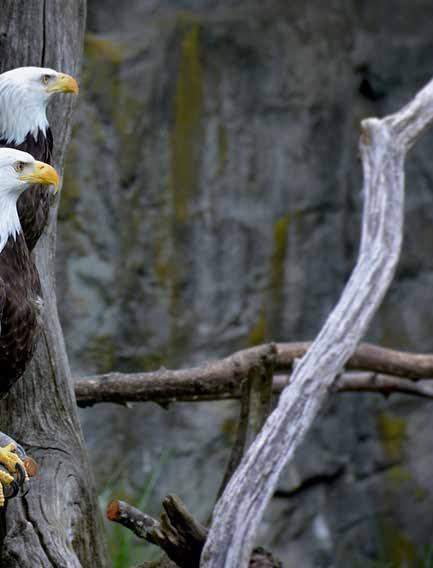
2022 december volume two © liveencounters.net A F A F E L B O U S T Y © Afaf Elbousty
©Afaf Elbousty

©liveencounters.net volume two december 2022 Celebrating 13th Anniversary N A T U R E 03

2022 december volume two © liveencounters.net A F A F E L B O U S T Y © Afaf Elbousty
©Afaf Elbousty

©liveencounters.net volume two december 2022 Celebrating 13th Anniversary N A T U R E 04

2022 december volume two © liveencounters.net A F A F E L B O U S T Y © Afaf Elbousty
©Afaf Elbousty

©liveencounters.net volume two december 2022 Celebrating 13th Anniversary N A T U R E 05

2022 december volume two © liveencounters.net A F A F E L B O U S T Y © Afaf Elbousty
©Afaf Elbousty

©liveencounters.net volume two december 2022 Celebrating 13th Anniversary N A T U R E 06
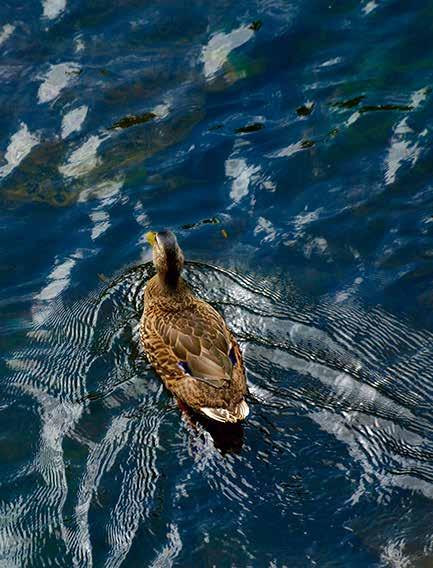
2022 december volume two © liveencounters.net A F A F E L B O U S T Y
© Afaf Elbousty
©Afaf Elbousty
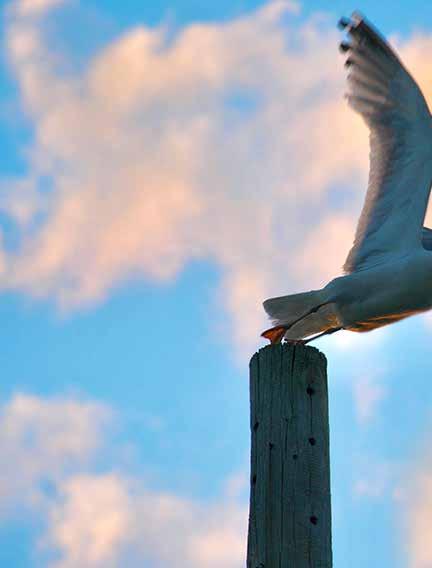
©liveencounters.net volume two december 2022 Celebrating 13th Anniversary N A T U R E 07

2022 december volume two © liveencounters.net A F A F E L B O U S T Y © Afaf Elbousty
©Afaf Elbousty

©liveencounters.net volume two december 2022 Celebrating 13th Anniversary B E A C H C O M B E R
Anni Wilton-Jones
Anni Wilton-Jones lives in Co Mayo, in Ireland, and specialises in photographing birds, land- & water-scapes and unusual details. She was commissioned by the SiarScéal Festival 2019 to produce a series of thirty photographs and poems for use in the children’s workshops.
Anni Wilton-Jones Beachcomber Photographs
The collection entitled Beachcomber is of photographs, which are taken on or beside the shore in the West of Ireland and which focus on the less-usually considered aspects of the everyday items and views of the coast.
2022 december volume two © liveencounters.net
A N N I W I L T O N - J O N E S © Anni Wilton-Jones

©liveencounters.net volume two december
2022 Celebrating 13th Anniversary
B E A C H C O M B E R
Colourful rocks with curlew, Bun na Thiarin, Co Mayo.
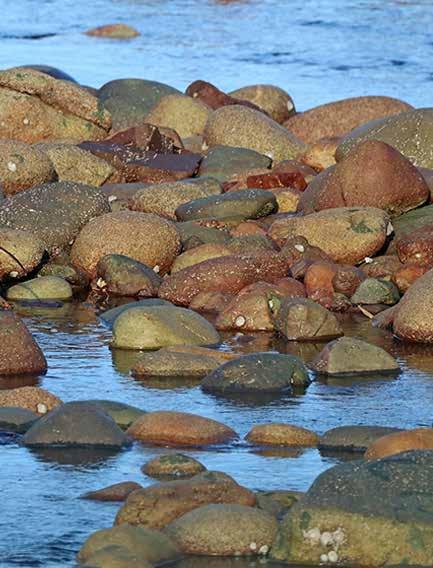
2022 december volume two © liveencounters.net A N N I W I L T O N - J O N E S © Anni Wilton-Jones

©liveencounters.net volume two december 2022 Celebrating 13th Anniversary
B E A C H C O M B E R
Sea cliffs, Claggan, Achill, Co Mayo

2022 december volume two © liveencounters.net A N N I W I L T O N - J O N E S © Anni Wilton-Jones

©liveencounters.net volume two december 2022 Celebrating 13th Anniversary
B E A C H C O M B E R
Lobster-pots, Cloughmore Pier, Achill, Co Mayo

2022 december volume two © liveencounters.net A N N I W I L T O N - J O N E S © Anni Wilton-Jones

©liveencounters.net volume two december 2022 Celebrating 13th Anniversary
B E A C H C O M B E R
Stonechat camouflaged in sea-rods, Easky, Co Sligo
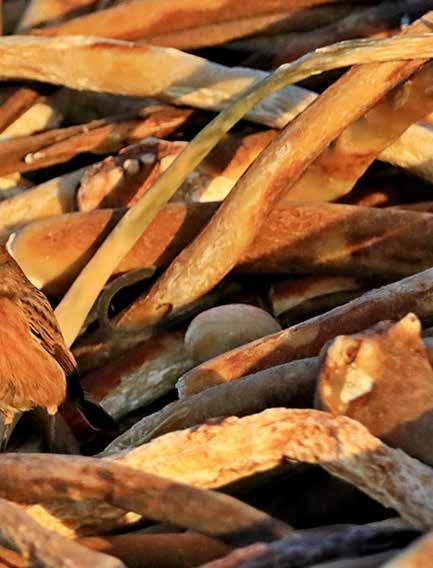
2022 december volume two © liveencounters.net A N N I W I L T O N - J O N E S © Anni Wilton-Jones

©liveencounters.net volume two december 2022 Celebrating 13th Anniversary
B E A C H C O M B E R
Slipway in low sun, Corraun Achill, Co Mayo

2022 december volume two © liveencounters.net A N N I W I L T O N - J O N E S © Anni Wilton-Jones


Volume Two December 2022
Magazine
2010 - 2022
Free Online
From Village Earth





















































































